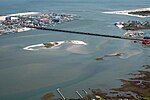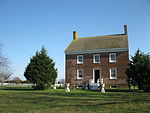Assateague State Park
1956 establishments in MarylandAssateague IslandBeaches of MarylandParks in Worcester County, MarylandProtected areas established in 1965 ... and 1 more
State parks of Maryland

Assateague State Park is a public recreation area in Worcester County, Maryland, located at the north end of Assateague Island, a barrier island bordered by the Atlantic Ocean on the east and Sinepuxent Bay on the west. The state park is bordered on both its north and south sides by Assateague Island National Seashore and is reached via the Verrazano Bridge which carries Maryland Route 611 across Sinepuxent Bay. The park offers wildlife viewing, beach activities, and camping facilities. It is managed by the Maryland Park Service of the larger Maryland Department of Natural Resources with the support of volunteers working under the auspices of the non-profit Friends of Assateague State Park.
Excerpt from the Wikipedia article Assateague State Park (License: CC BY-SA 3.0, Authors, Images).Assateague State Park
Geographical coordinates (GPS) Address Nearby Places Show on map
Geographical coordinates (GPS)
| Latitude | Longitude |
|---|---|
| N 38.252777777778 ° | E -75.127777777778 ° |
Address
Worcester County
Maryland, United States
Open on Google Maps






